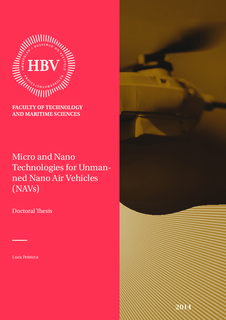| dc.contributor.author | Petricca, Luca | |
| dc.date.accessioned | 2014-05-27T11:30:00Z | |
| dc.date.available | 2014-05-27T11:30:00Z | |
| dc.date.issued | 2014 | |
| dc.identifier.issn | 1894-7530 | |
| dc.identifier.uri | http://hdl.handle.net/11250/195549 | |
| dc.description.abstract | Nano Air Vehicles (NAVs) consist of remotely controlled miniaturized flying objects
with maximum dimensions smaller than 15 cm and less than 20 g in weight. The small size of such systems allows them to penetrate and collect data from regions that are inaccessible to other vehicles. They could provide great advantage in many life threatening situations. Intelligence Surveillance and Reconnaissance (ISR) are typical applications for NAVs.They can also be used as extended senses in dangerous environments such as collapsed mines and buildings; disasters in nuclear power plant etc.
Despite their small size, these vehicles are extremely complex and provide a fusion of
different research areas such as micro technology, electronics, material science,
informatics, control theory, mechanics, aerodynamics and physics. Many large universities and institutes (such as [1] (DARPA)) have been studying and developing them for almost ten years.
This Ph.D. work is focused on finding micro and nano technologies suitable to be used
onboard in NAVs. It starts with the review of the state of art of such systems, breaking
them into basic blocks and finding the integration bottlenecks. We then investigated micro technologies based devices that can be used to improve their performance. In particular, we present piezoresistive accelerometers and microphones fabricated with the MultiMEMS process, with an explanation of the measurement set up used and the results from the analytical and Finite Elements Method (FEM) models of the sensors.
The work continues presenting a simple and innovative solution for PCB to PCB
interconnections. It consists of a small interposer complete with multiple vias to be placed in between two PCB boards. The interposer is designed for creating electrical and mechanical connections at the same time, while leaving enough space in between on the PCBs for electric component placement. The reliability of this solution has been tested by vibration and temperature cycling tests.
During this project, it also developed one of the smallest autopilot system in the world
based on STM32 microcontroller and complete with 2.4 GHz wireless interface and 9 axis DOF inertial motion unit (IMU). The small dimensions (28x21 mm2) and the low weight (1.2 g) of this autopilot, makes it the perfect candidate to be used onboard in NAVs.
The thesis includes also a review of energy storage systems, their limitations and possible alternatives, for future vehicles. Furthermore, I also present the initial work done on supercapacitor devices based on black silicon, including the fabrication and analysis of two different silicon wafers as well as a suggested detailed process for the creation of those devices. | nb_NO |
| dc.language.iso | eng | nb_NO |
| dc.relation.ispartofseries | Doctoral theses at Buskerud and Vestfold University College;2 | |
| dc.relation.haspart | Paper 1: Micro- and Nano-Air Vehicles: State of the Art. Luca Petricca, Ohlckers, Per and Grinde, Christopher: International Journal of Aerospace Engineering. Volume 2011, Article ID 214549, 17 pages. DOI:10.1155/2011/214549 | nb_NO |
| dc.relation.haspart | Paper 2: A miniaturized bulk micromachined triaxial accelerometer fabricated using deep reactive etching through a multilevel thickness membrane Luca Petricca, Christopher Grinde and Per Ohlckers: Journal of Microsystem Technologies, Springer, Volume 18, Number 5 (2012), 613-622, DOI: 10.1007/s00542-012- 1429-9 | nb_NO |
| dc.relation.haspart | Paper 3: Analytic model and FEM characterization of two piezoresistive microphone membrane Luca Petricca; Per Ohlckers; MEMSM 2013: Proceedings of the MEMS Mechanics, 15-16 March 2013, Wuhan | nb_NO |
| dc.relation.haspart | Paper 4: Ultra low weight spacer for PCB to PCB interconnections Luca Petricca; Per Ohlckers; Geir M. Mellem, IMAPS Journal of Microelectronics and Electronic Packaging 2014. Vol. 11, Issue 1, p 42-50. DOI: 10.4071/imaps.396 | nb_NO |
| dc.subject | VDP::Teknologi: 500::Nanoteknologi: 630 | nb_NO |
| dc.title | Micro and Nano Technologies for Unmanned Nano Air Vehicles (NAVs) | nb_NO |
| dc.type | Doctoral thesis | nb_NO |
| dc.source.pagenumber | 79 | nb_NO |
